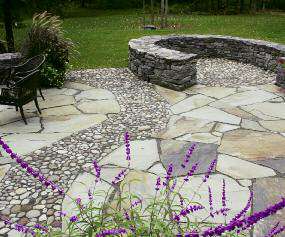On the Level
'Early in the history of garden design - dating back to the earliest days of civilization in Sumeria, Egypt and China - plants took center stage in garden spaces.' With that observation, Bruce Zaretsky opened his On the Level column in February 2009, then added: 'Terraces and hanging gardens were built not for their innate ornamental qualities, but rather to display the plants they contained. Always, the prized plant was
Writing about droughts and water shortages in his March 2008 On the Level column, Bruce Zaretsky started by observing, ‘This turn of events has made me determined to design landscapes requiring as little water as possible – one consequence being that I now do all I can to avoid using large expanses of
‘It seems that everyone’s talking about “sustainability” these days, with the usual thought being that, as exterior designers, good environmental stewardship must be one of our main missions.’ That’s the way Bruce Zaretsky opened his On the Level column five years ago before asking a string of key questions: ‘But what is sustainability? What do watershapers need to do to encompass this philosophy? As important, what does it mean to our clients, and where are
‘Those of us who are designers and builders of full-scale outdoor environments . . . face a distinct challenge: In our work for our clients, we are expected to provide the outline and details for a huge range of project elements, from watershapes and patios to plantings and walkways and more.’ That’s how Bruce Zaretsky began his On the Level column in WaterShapes’ November 2007 edition. ‘That list, at least so far as clients are concerned, also includes appropriate lighting, but that is not always something
Bruce Zaretsky opened his very first On the Level column back in August 2007 with a question: ‘Does the size of a project or its budget correlate with its creativity or quality?’ ‘I know many of us have clients who think that way, believing the more money they spend, the better product they’re going to get,’ he wrote. ‘And my best guess is that there are
'One of the most common themes repeated in [WaterShapes] is that selecting materials for projects can make the difference between truly artistic designs and those that are either inappropriate or just plain boring,' wrote Bruce Zaretsky to open his On the Level column in the December 2010 issue. 'Materials truly matter, and the importance of knowing your options and
'If you ask my employees,' wrote Bruce Zaretsky in starting his July 2010 On the Level column, 'they'll tell you that I'm an unrelenting pain in the neck - a real tyrant. That's because I'm always asking nagging sorts of questions such as, "Why isn't this project finished yet?" or "How much longer is this going to take?" or "Can you speed things up?" 'My questions, of course, are somewhat unfair. . . . But I have no reluctance to come across as a tyrant
'I've taken up a fair amount of my column space in WaterShapes with discussions of the wise use of water, and for good reason: What could be more important to watershapers,' wrote Bruce Zaretsky to open the April 2010 edition of On the Level, 'than knowing how to make the best possible use of the material that defines our profession? 'The common thread in all of this coverage . . . is that, ultimately, our aim must be to preserve the integrity of water, to cleanse it for return to the groundwater system and to
We water and landscape professionals literally shape the outdoor environments in which we work – cutting grades, building walls, planting trees, installing pools, ponds and fountains and preparing patios, decks, planting beds and lighting systems. In designing these outdoor-living spaces, we spend the bulk of our time
















